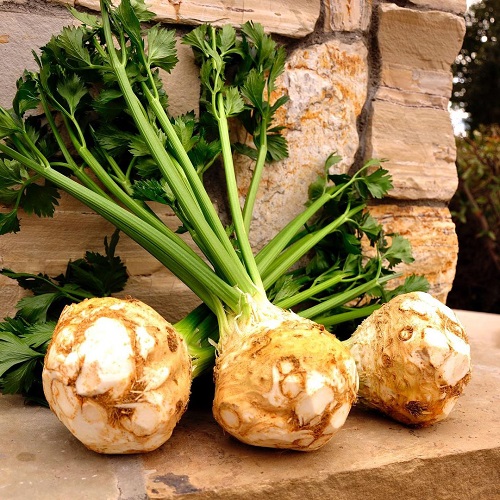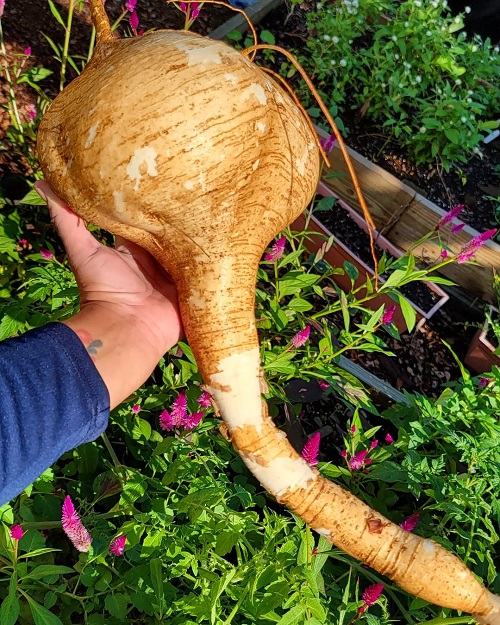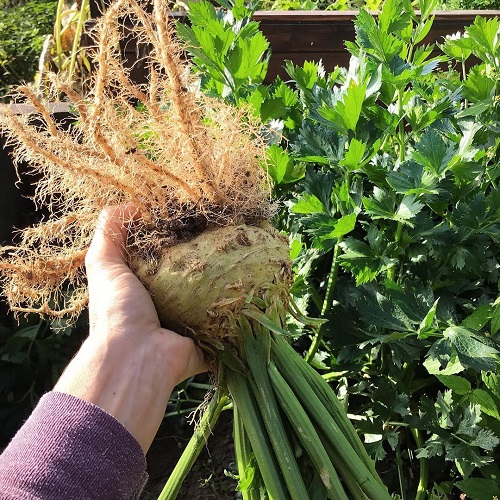Celery Root vs Jicama: Are you also confused between the two? Don’t worry! We will guide you with all the details!
Celery Root vs Jicama – well, this is quite a topic of discussion for many gardeners and we are here to make things easy for you once and for all!
What is a Celery Root?

Celery root, also known as celeriac, is a root vegetable that is closely related to celery. It is cultivated for its underground tuber, which has a similar flavor profile to celery but is more earthy and nutty.
This vegetable is especially popular in European cuisines and is gaining traction in the United States as well.
Celery root is a knobby, brown-skinned vegetable that resembles a turnip. Its flesh is off-white and has a crisp texture. The root typically weighs between 1 to 4 pounds and can be up to 5 inches in diameter.
Cooking Methods
- Boiling: Often used in soups and purees.
- Roasting: Can be seasoned and roasted as a side dish.
- Grating: Used raw in salads or slaws.
What is a Jicama?

Jicama (pronounced HEE-ka-ma) is a root vegetable native to Mexico and Central America. Also known as the Mexican yam bean or Mexican turnip, jicama has gained popularity in the United States and other parts of the world for its crisp texture and mildly sweet, nutty flavor.
The plant belongs to the legume family and is primarily grown for its large, tuberous root.
Jicama is a round or oblong-shaped vegetable with a thin, brown skin and a crisp, white flesh. The roots can weigh anywhere from 1 to 6 pounds, and its exterior texture resembles that of a potato or turnip.
Cooking Methods
- Raw: Often sliced or julienned for use in salads and slaws.
- Stir-Frying: Retains its crunchy texture even when cooked briefly.
- Boiling: Less common but can be used in soups.
Celery Root vs Jicama – Differences

Appearance
- Celery Root: Celery root has a knobby, brownish exterior, resembling a rough, gnarled root. When peeled, it reveals a creamy-white flesh inside.
- Jicama: Jicama is covered by a tan, papery skin that requires peeling to access its edible part. Inside, it features a crisp, juicy, and white flesh akin to water chestnuts.
Smell
- Celery Root: Celery root has a mild, slightly nutty aroma, with hints of celery and parsley.
- Jicama: Jicama doesn’t possess a strong smell when fresh. However, some may detect a faint, slightly sweet scent.
Flavor
- Celery Root: Celery root offers a mild flavor with subtle nutty notes, along with hints of celery and parsley. The flavor is not as pronounced as that of celery stalks
- Jicama: Jicama boasts a mild, crisp, and slightly sweet flavor, often likened to a combination of apple and pear, with a hint of nuttiness.
Texture
- Celery Root: Celery root has a dense and sometimes starchy texture, particularly when cooked. It can be mashed, roasted, or pureed.
- Jicama: Jicama is renowned for its crisp, refreshing texture, resembling water chestnuts. It retains its crunchiness, making it a popular choice for raw preparations.
Culinary Uses
- Celery Root: Celery root is commonly used in cooked dishes, such as soups, stews, and gratins. It’s versatile and a staple ingredient in French cuisine.
- Jicama: Jicama is primarily enjoyed raw in salads, salsas, and slaws. It adds a refreshing crunch to Latin American and other cuisines’ dishes.
Nutrition
- Celery Root: Celery root is a good source of dietary fiber, vitamins (particularly vitamin K and vitamin C), and essential minerals like phosphorus and potassium.
- Jicama: Jicama is low in calories and fat, making it a healthy choice for snacks or salads. It provides dietary fiber and vitamin C, offering a refreshing and nutritious addition to various dishes.
Celery Root vs Jicama – Similarities

Physical Characteristics
- Tubers: Both celery root and jicama are tuberous root vegetables.
- Color: The external color of both vegetables is brownish or beige.
Culinary Uses
- Versatility: Both can be used in various culinary applications like salads, stir-fries, and roasts.
- Raw Eating: Both celery root and jicama can be consumed raw.
- Flavor Profile: They both offer a mildly sweet, nutty flavor when eaten raw.
Nutritional Value
- Low-Calorie: Both are low in calories, making them suitable for weight-loss diets.
- Fiber Content: Both are rich in dietary fiber, good for digestive health.
- Nutrient-Dense: They offer essential nutrients like potassium and vitamin C.
Agricultural Aspects
- Soil Requirements: Both prefer well-drained soil for optimal growth.
- Harvest Time: The root of both plants is harvested after the growing season.
Storage and Shelf-life
- Long-lasting: Both celery root and jicama have a relatively long shelf-life compared to other vegetables when stored properly.
- Storage Conditions: Both should be stored in a cool, dry place but not necessarily in the refrigerator.
Other Similarities
- Gluten-Free: Both are gluten-free, making them ideal for those with gluten intolerances.
- Non-GMO: Generally, both celery root and jicama are non-GMO vegetables.
Celery Root vs Jicama – FAQs
1. Are They Interchangeable in Recipes?
While both can be eaten raw and have a crunchy texture, their flavors differ slightly. Celery root has a more earthy, celery-like taste, while jicama is sweeter. They can sometimes be substituted for each other, depending on the recipe.
2. Which is Healthier?
- Both are low in calories and high in fiber, but they offer different nutrients. Celery root is a good source of Vitamin K and B6, while jicama is rich in Vitamin C and iron.
3. Can They be Eaten Raw?
Both celery root and jicama can be consumed raw and are often used in salads and slaws.
4. How Long Can They be Stored?
Celery root can last up to 3 weeks in a cool, dark place. Jicama can be stored for 1-2 weeks at room temperature and up to 4 weeks when refrigerated.
5. Do They Require Peeling?
Both vegetables have a tough, inedible skin that needs to be peeled before consumption.
6. Can They be Cooked?
Both celery root and jicama can be cooked. They can be roasted, boiled, or included in stews and stir-fries.
7. Are They Allergen-Free?
Both are generally safe for those with common food allergies, but as with any food, individual reactions can vary.
8. Where Can They be Found?
Celery root is more commonly found in European cuisines and grocery stores with a European focus. Jicama is often available in Latin American markets and is becoming increasingly common in mainstream grocery stores in the U.S.

